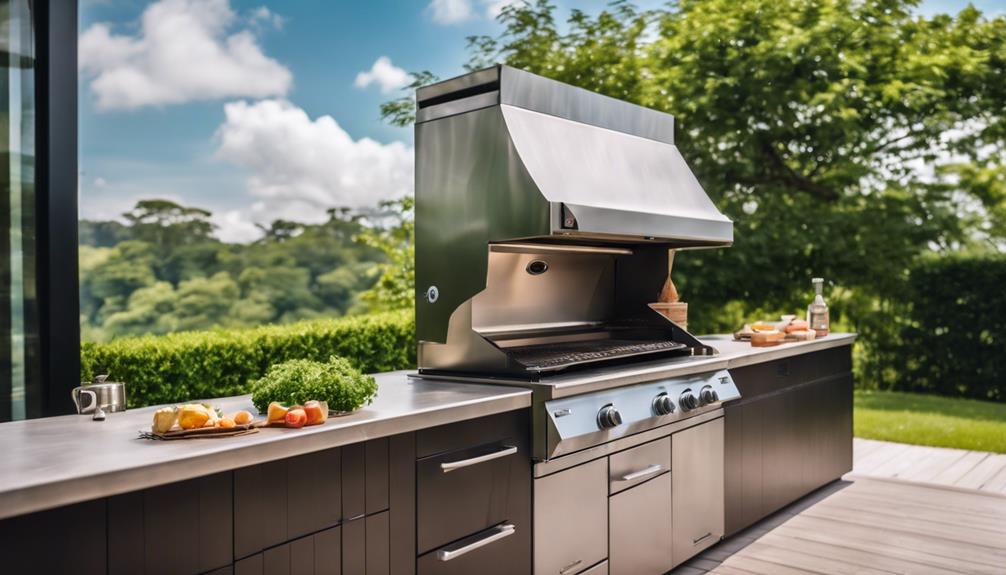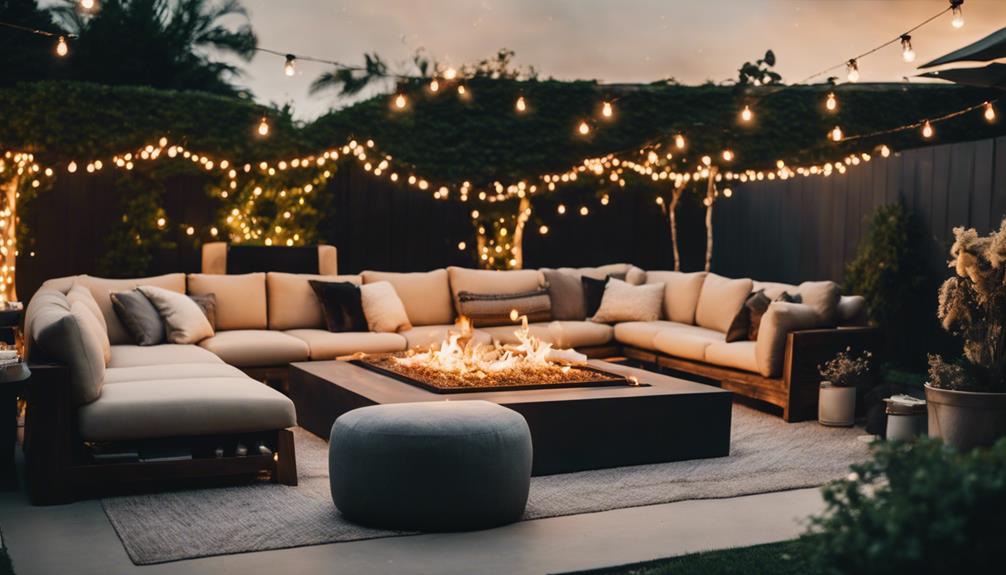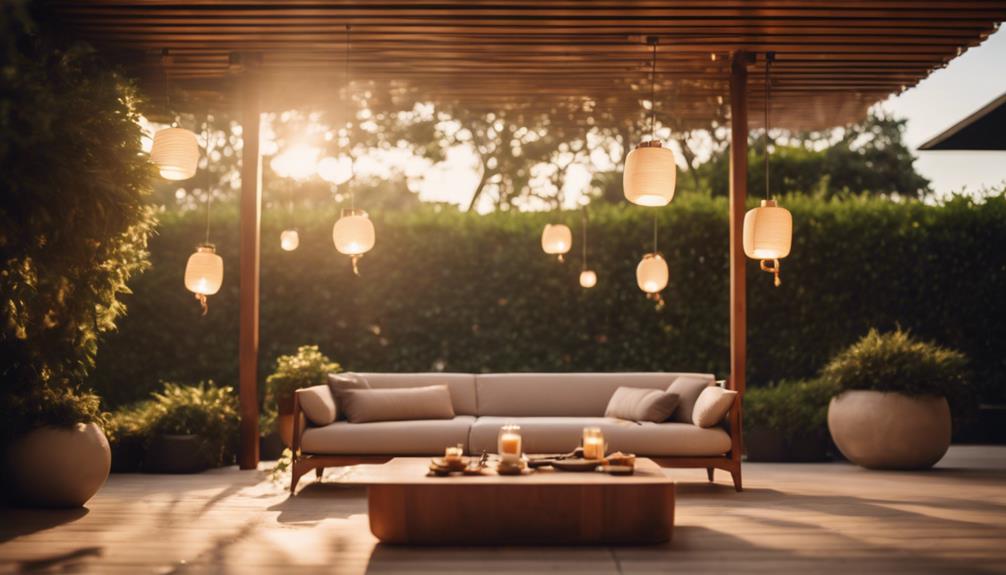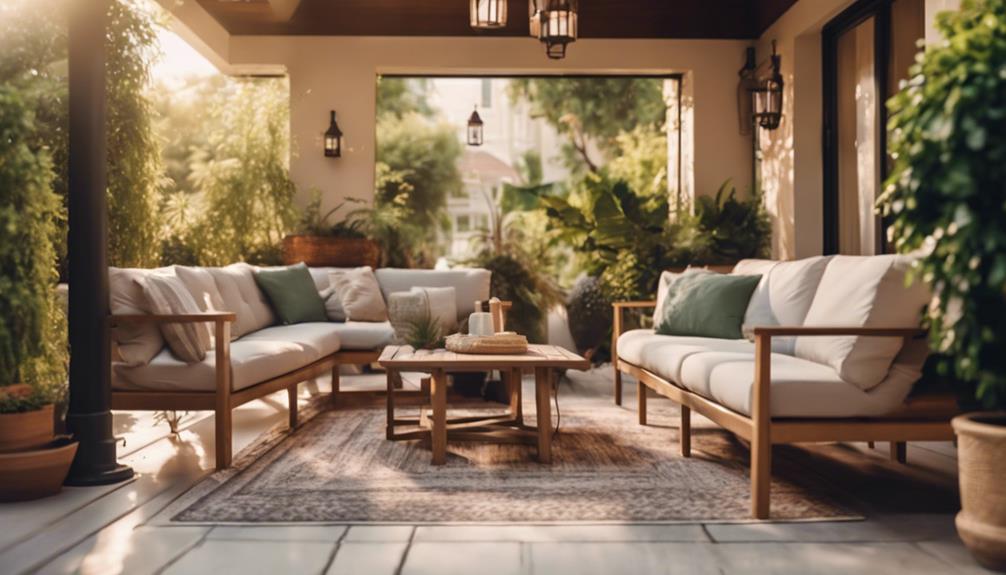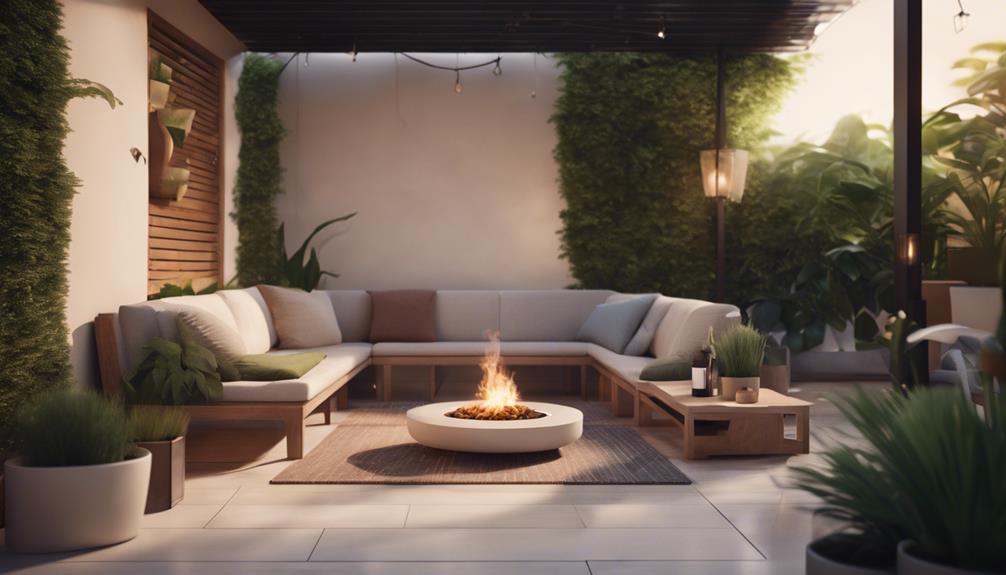You've invested in creating the perfect outdoor kitchen, but without a reliable ventilation system, your outdoor space can quickly become overwhelmed by smoke and grease. That's where an Alfresco rangehood comes in! These powerful ventilation systems capture grease and particles, expel smoke and heat, and remove odors, creating a cleaner and more comfortable cooking environment. With various sizes and styles available, you can choose the perfect rangehood for your outdoor kitchen. From durable stainless steel materials to weather-resistant designs, you'll find the perfect fit. Now, let's get started on finding the ideal rangehood for your outdoor oasis!
Key Takeaways
- Alfresco rangehoods provide powerful ventilation to remove smoke and odors, keeping your outdoor kitchen clean and comfortable.
- Durable stainless steel construction ensures rust resistance and low maintenance, perfect for outdoor use.
- High CFM ratings and efficient ventilation systems create a smoke-free environment, enhancing the cooking experience.
- Weather-resistant materials and robust designs can withstand harsh outdoor conditions, ensuring reliable performance.
- Regular maintenance and ideal installation height maximize rangehood performance, keeping your outdoor kitchen smoke-free.
Rangehood Options for Outdoor Kitchens
When designing your outdoor kitchen, you're faced with a multitude of rangehood options, but Alfresco's offerings stand out for their ability to efficiently eliminate smoke and cooking fumes. With Alfresco's Outdoor Range Hood, you can enjoy a smoke-free cooking experience, no matter the size or style of your outdoor kitchen. Their rangehoods come in various sizes and styles to fit your unique setup, and are built with durable materials like stainless steel to withstand the outdoor elements.
What really sets Alfresco apart is their powerful ventilation capabilities. Their rangehoods boast high CFM ratings, making them perfect for heavy-duty outdoor cooking. Imagine being able to cook up a storm on your outdoor BBQ, without the hassle of smoke and fumes getting in the way.
With Alfresco's Stainless Steel Outdoor Vent, you can enjoy a cleaner and more comfortable cooking environment. Whether you're a seasoned outdoor chef or just starting out, Alfresco's rangehood options are sure to impress.
Importance of Ventilation Systems
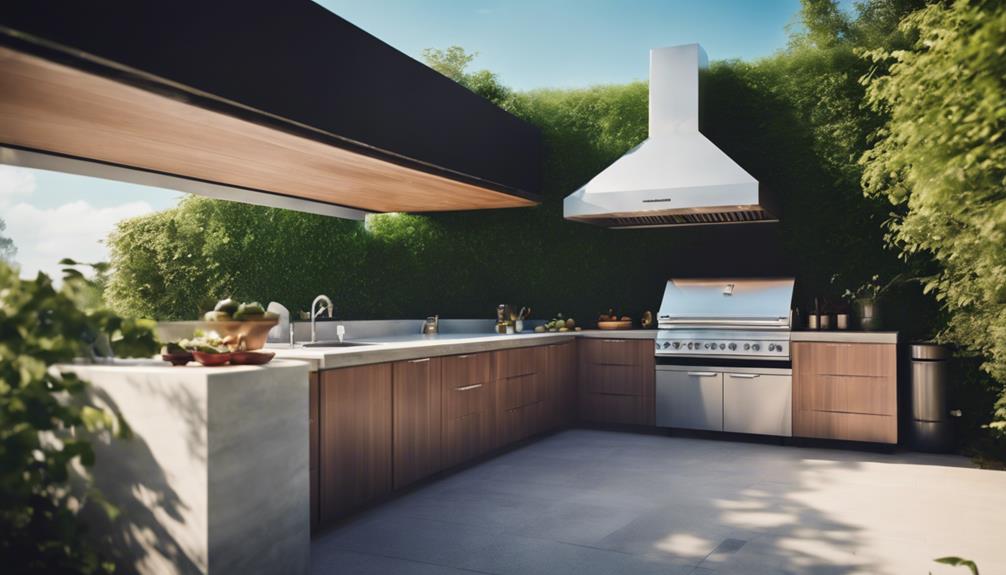
Proper ventilation systems, like Alfresco range hoods, are the unsung heroes of outdoor kitchens, working tirelessly to remove smoke, heat, and odors, ensuring a more enjoyable cooking experience. You might not think about it, but without a good ventilation system, your outdoor kitchen can quickly become a haze of smoke and grease. But with an Alfresco range hood, you can breathe easy, knowing that the air is being circulated and cleaned.
Here's what you can expect from a quality ventilation system like an Alfresco range hood:
| Benefit | Description | Importance |
|---|---|---|
| Improved Air Quality | Removes pollutants and grease from the air | High |
| Enhanced Comfort | Maintains a comfortable cooking environment | Medium |
| Increased Safety | Reduces risk of fire and health hazards | High |
Choosing the Right Materials
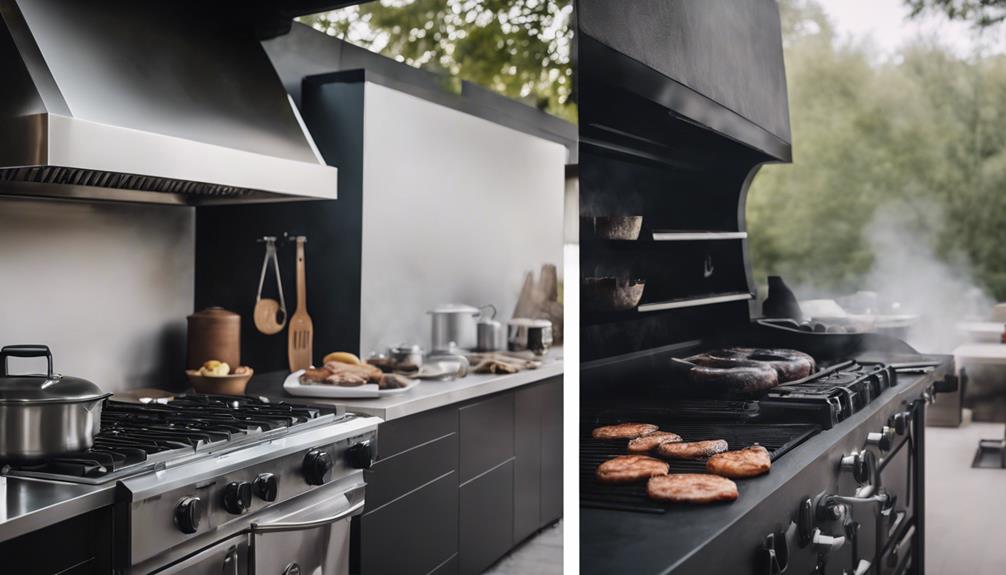
When it comes to choosing the right materials for your Alfresco rangehood, you're not just picking something that looks nice – you're investing in the longevity of your outdoor kitchen.
You want materials that can withstand the elements and keep on performing, which is why durability and weather resistance are key considerations.
Let's explore the benefits of materials like stainless steel, Engineered Concrete Composite, and High Performance Concrete that'll keep your outdoor kitchen smoke-free and stress-free.
Material Durability Matters
By choosing durable materials like 304 stainless steel, you guarantee that your alfresco rangehood can withstand the harsh outdoor elements and maintain its performance over time. You don't want your outdoor appliance to rust or deteriorate quickly, do you? That's why selecting the right materials is essential.
Here are some essential factors to take into account:
- Weather-resistance: Your range hood will be exposed to rain, sunlight, and extreme temperatures, so it's important to choose materials that can withstand these conditions.
- Durability: A stainless steel construction ensures your range hood remains durable and efficient for years to come.
- Low maintenance: Choose materials that are easy to clean and maintain to save you time and hassle.
- Aesthetics: Your range hood should complement your outdoor kitchen's design, so pick materials that fit your style.
Stainless Steel Benefits
You'll appreciate the numerous benefits of stainless steel when choosing the right materials for your alfresco rangehood, particularly its exceptional durability and resistance to rust and corrosion. This means you can enjoy outdoor cooking without worrying about your range hood deteriorating over time.
Plus, stainless steel is a breeze to clean and maintain, making it perfect for outdoor environments exposed to the elements. A stainless steel range hood provides a sleek and modern look that complements various outdoor kitchen designs, adding a touch of sophistication to your alfresco space.
What's more, this material is heat-resistant, ensuring top-notch performance and longevity in high-temperature cooking settings. By choosing stainless steel for your outdoor range hood, you're investing in a high-quality, long-lasting solution for your alfresco cooking space.
With stainless steel, you can focus on what matters most – enjoying delicious meals with family and friends in your outdoor kitchen.
Weather Resistance Counts
Choose the right materials for your outdoor range hood, and you'll greatly reduce the risk of damage from harsh outdoor elements. You want a material that can withstand the rain, wind, and sun exposure, and still look sleek and modern. That's where weather-resistant materials like 304 stainless steel come in.
Here are some benefits of choosing weather-resistant materials for your outdoor range hood:
- Corrosion resistance: 304 stainless steel is resistant to rust and corrosion, making it perfect for outdoor use.
- Durability: It can withstand harsh outdoor conditions, ensuring your range hood lasts for a long time.
- Low maintenance: Weather-resistant materials require minimal upkeep, saving you time and effort.
- Sleek appearance: 304 stainless steel offers a modern and stylish look that complements your outdoor kitchen.
Key Features to Consider
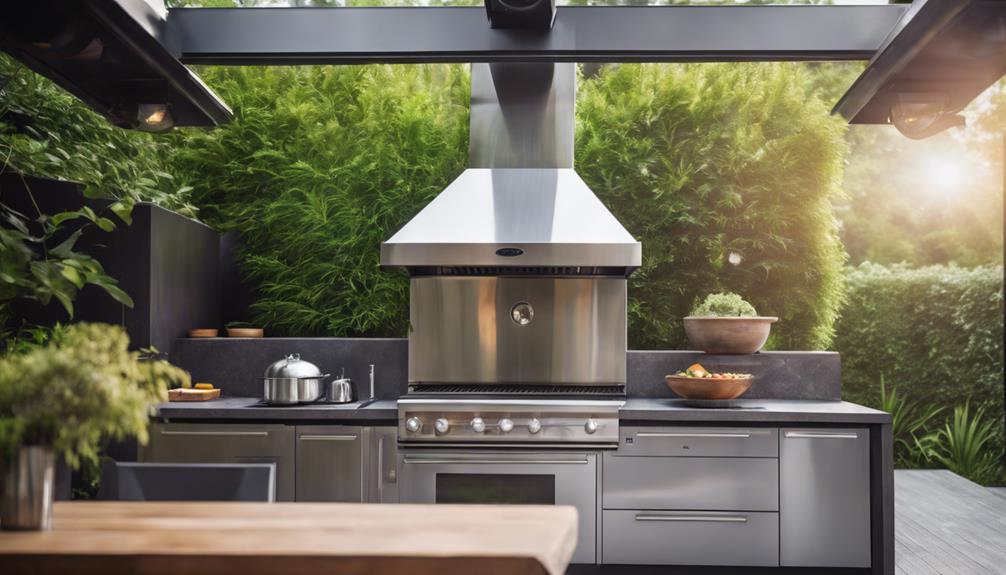
When selecting an Alfresco rangehood, it is essential to prioritize features that ensure efficient ventilation and durability in outdoor kitchen environments. You want a rangehood that can handle the demands of outdoor cooking, right?
Here are the key features to take into account:
| Feature | Why it matters |
|---|---|
| High CFM power | Effectively removes smoke, grease, and odors from your outdoor kitchen |
| Durable stainless steel construction | Withstands harsh outdoor conditions and easy to clean |
| Weather-resistant design | Protects internal components from the elements |
Designing for Durability
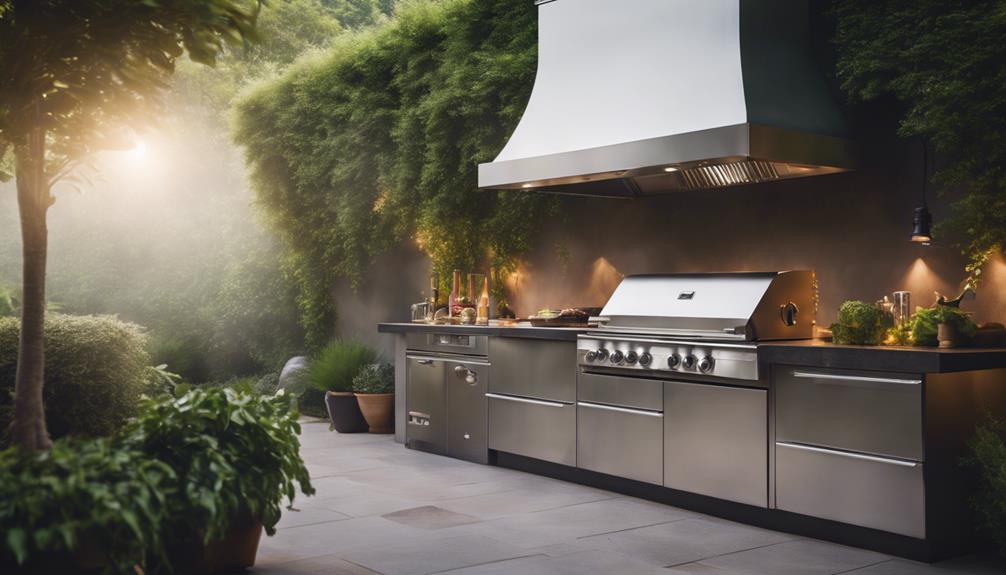
Constructed to withstand the elements, Alfresco rangehoods boast a robust build that guarantees their durability in outdoor kitchen environments. You can trust that they'll keep your outdoor living space smoke-free, no matter the weather.
Here's what makes them so durable:
- Stainless steel construction: Alfresco rangehoods are built to last, with high-quality stainless steel that resists rust and corrosion.
- Weather-resistant materials: They're designed to withstand harsh outdoor conditions, ensuring long-lasting performance in any climate.
- Powerful fan: A strong fan ensures efficient ventilation, even in windy or humid conditions.
- Robust design: With a focus on durability, Alfresco rangehoods are crafted to provide reliable ventilation in outdoor kitchen settings.
Benefits of Alfresco Rangehoods
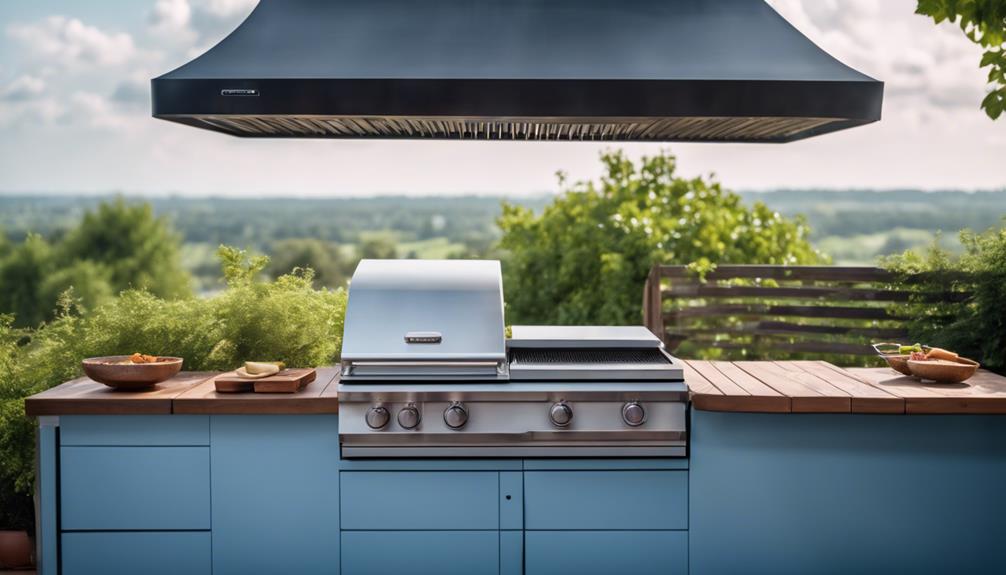
Now that you've got a durable alfresco rangehood, it's time to reap the benefits!
You'll love how it effectively removes unwanted odors, improves the air quality, and creates a more enjoyable ambiance in your outdoor kitchen.
With these perks, you'll be cooking up a storm in no time!
Effective Odor Removal
With their powerful CFM ratings, Alfresco rangehoods can effectively eliminate smoke and odors from your outdoor kitchen, guaranteeing a fresh and clean cooking environment. You'll no longer have to deal with lingering smells or hazy skies while cooking alfresco. These rangehoods are designed to vent smoke and odors away from your cooking space, creating a more enjoyable experience for you and your guests.
Here are just a few ways Alfresco rangehoods remove odors from your outdoor kitchen:
- Powerful Ventilation: Their high CFM ratings make sure that smoke and odors are quickly removed from the air.
- Effective Filtration: Alfresco rangehoods come equipped with filters that trap grease and food particles, reducing odors and smoke.
- Durable Design: Built with stainless steel and other durable materials, these rangehoods can withstand the elements and continue to perform well.
- Customizable Sizes: With various sizes available, you can find an Alfresco rangehood that fits your outdoor kitchen layout and design.
Improved Air Quality
By reducing smoke and odors, your Alfresco rangehood helps you breathe easier, creating a more inviting atmosphere in your outdoor kitchen. You can finally enjoy cooking on your outdoor grill without worrying about the air quality. With an alfresco rangehood, you can say goodbye to the hassle of lingering smoke and hello to a more comfortable cooking experience.
Here's a breakdown of how alfresco rangehoods improve air quality:
| Feature | Benefit | Explanation |
|---|---|---|
| Captures grease and particles | Reduces air pollutants | Prevents accumulation on surfaces |
| Expels smoke and heat | Maintains comfort | Even during high-temperature grilling |
| Various CFM options | Suits different outdoor kitchens | Ensures proper ventilation |
| Effective odor removal | Eliminates unpleasant smells | Creates a more enjoyable atmosphere |
| Range hood sizes | Fits various outdoor grill setups | Customizable for your outdoor kitchen |
Enhanced Ambiance
Alfresco rangehoods guarantee your outdoor kitchen transforms into a warm and inviting space, perfect for relaxing and socializing with family and friends while savoring a delicious meal. With an alfresco rangehood, you can enjoy a smoke-free outdoor kitchen, free from the distractions of smoke and odors. This allows you to focus on what really matters – the company, the food, and the ambiance.
Here are just a few ways alfresco rangehoods enhance the ambiance of your outdoor kitchen:
- Improved visibility: With a range that's free from smoke and steam, you can see clearly and enjoy the beautiful surroundings of your outdoor kitchen.
- Enhanced comfort: By removing heat and smoke, alfresco rangehoods create a more comfortable outdoor dining space, perfect for relaxing with loved ones.
- Increased enjoyment: Without the nuisance of smoke and odors, you can focus on enjoying your meal and the company of others.
- Better entertaining: An alfresco rangehood guarantees your outdoor kitchen is always ready for entertaining, whether it's a casual dinner or a backyard bash.
Outdoor Kitchen Ventilation Needs
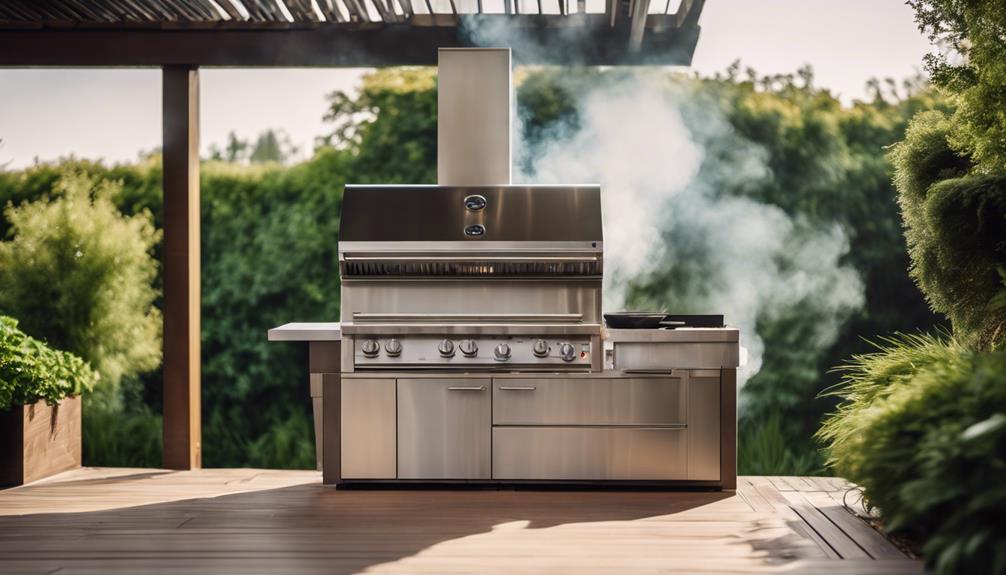
As you design your outdoor kitchen, you'll quickly realize that ventilation is a critical component, as it directly impacts the air quality and overall comfort of your cooking space. Without proper ventilation, your outdoor kitchen can become a smoke-filled nightmare, making it unbearable to cook and entertain. That's where Alfresco rangehoods come in – designed specifically for outdoor use to effectively capture and extract cooking byproducts.
| Ventilation Needs | Considerations | Solutions |
|---|---|---|
| Size of kitchen | Larger kitchens require more powerful ventilation | Island Mount rangehoods for maximum airflow |
| Type of cooking equipment | Gas grills, charcoal grills, and smokers produce different byproducts | Outdoor vent hoods with adjustable speed settings |
| Number of users | More users mean more cooking, requiring more ventilation | High-capacity rangehoods for heavy usage |
| Climate and weather | Extreme temperatures and humidity affect ventilation needs | Weather-resistant rangehoods with durable materials |
| Personal preferences | Some homeowners prioritize quiet operation or sleek design | Customizable rangehoods with silent operation and modern designs |
Types of Rangehood Installations
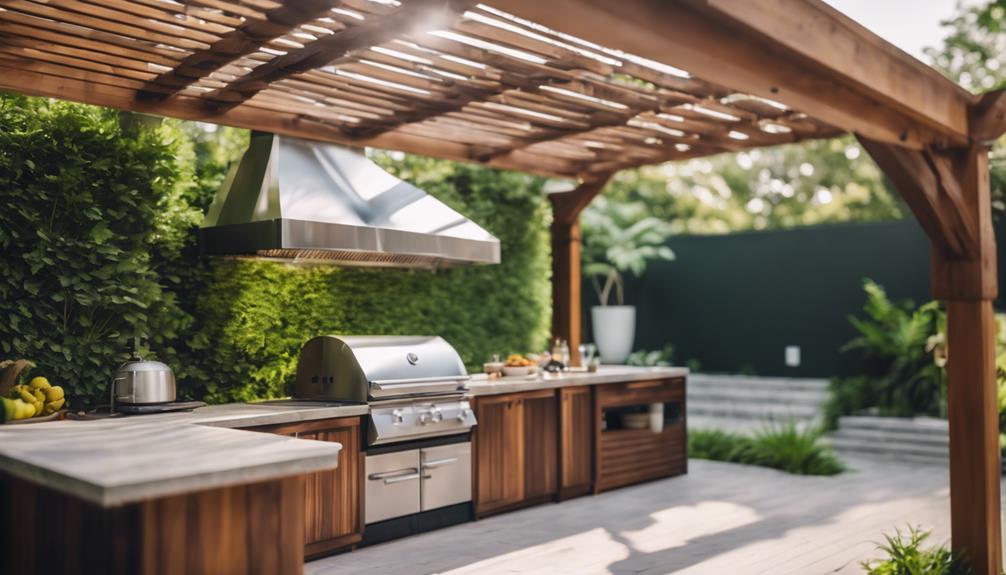
You've got several options for installing a rangehood in your outdoor kitchen, depending on your layout and design preferences. The type of installation you choose will impact the look and functionality of your outdoor kitchen.
Here are some common types of rangehood installations to take into account:
- Wall Mount Range Hood: Installed against a wall above the cooking area, these rangehoods are a great option for kitchens with a linear layout.
- Island Range: Suspended from the ceiling over an island or cooking space, these rangehoods are perfect for kitchens with a central cooking station.
- Hood Insert: Built into custom cabinetry, these rangehoods provide a seamless look in outdoor kitchens.
- Ducted Range Hood: These rangehoods require venting outside to remove smoke and odors effectively, making them a great choice for kitchens with limited ventilation.
When choosing a rangehood installation, take into consideration the size and style of your outdoor kitchen, as well as your personal design preferences. With so many options available, you're sure to find the perfect fit for your outdoor kitchen.
Maximizing Rangehood Performance
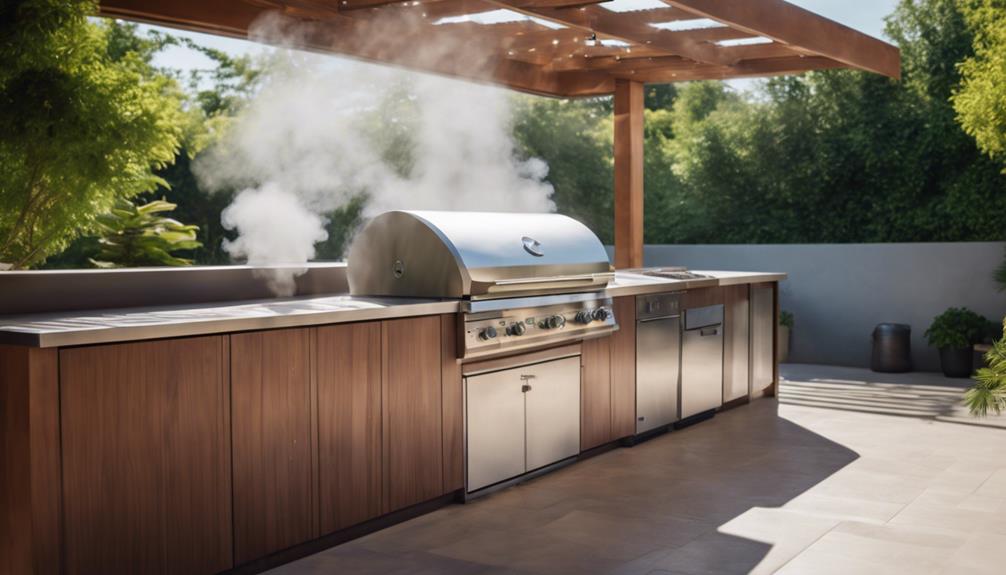
For peak performance of your rangehood, it's essential to install it at the ideal height, between 24 and 30 inches above the cooking surface, to effectively capture smoke, grease, and odors.
You'll be amazed at how well your Alfresco rangehood performs when installed at the right height! With its commercial-grade stainless steel construction, it's built to last in your outdoor kitchen. Plus, its powerful CFM ratings make certain that your outdoor space stays smoke-free and fresh.
To keep your rangehood running smoothly, don't forget to maintain it regularly. Clean those filters and ducts to ensure top-notch performance. You wouldn't want your rangehood to underperform, would you?
Remember, a well-maintained rangehood is a happy rangehood! With various sizes to suit your outdoor kitchen setup, you can trust that your Alfresco rangehood will be the perfect addition to your outdoor cooking space.
Outdoor Kitchen Design Essentials
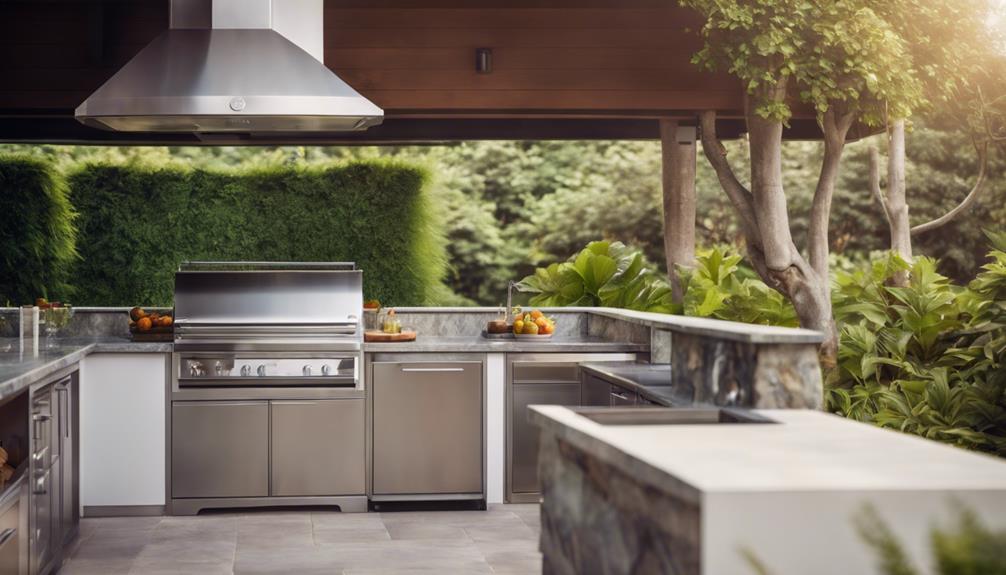
When designing your outdoor kitchen, you typically prioritize durable materials like stainless steel to guarantee your space can withstand the elements. This is important because you want your outdoor kitchen to last for years to come.
But, did you know that there's more to outdoor kitchen design than just durable materials? Here are some essentials to keep in mind:
- Proper Ventilation: A good outdoor kitchen hood is vital for removing smoke, heat, and odors from your cooking area.
- Functional Layout: A well-planned layout ensures a smooth cooking experience and adequate storage for your utensils and ingredients.
- Comfortable Seating: A cozy seating area invites your guests to linger and enjoy the outdoor ambiance.
- Adequate Lighting: Proper lighting sets the mood and provides sufficient illumination for cooking and socializing.
Frequently Asked Questions
Do Kitchen Range Hoods Need to Be Vented Outside?
So, do kitchen range hoods need to be vented outside? Absolutely! Venting outside is essential to remove smoke, odors, and grease from your kitchen.
If you don't, you'll be breathing in pollutants and creating an unhealthy environment. Plus, it's a safety risk and can damage your kitchen materials.
Do Range Hoods Help With Smoke?
You're probably wondering, do range hoods really help with smoke?
The short answer is yes, they're super effective!
Range hoods are designed to remove smoke and odors from your outdoor kitchen, creating a cleaner and more enjoyable cooking environment.
They work by using powerful fans to extract smoke and pollutants, greatly reducing smoke buildup during grilling and cooking activities.
Does an Outdoor Kitchen Need a Rangehood?
So, you're wondering if an outdoor kitchen really needs a rangehood?
The answer is a big yes! Without one, smoke and grease from cooking can linger, making your outdoor space uncomfortable and even posing safety risks.
A rangehood guarantees proper ventilation, removing smoke, grease, and odors, and keeping your outdoor kitchen clean and safe.
Trust us, you don't want to cook without one!
How Do You Fire Proof an Outdoor Kitchen?
Are you worried about your outdoor kitchen going up in flames?
To fireproof it, you'll want to use fire-resistant materials like concrete, stone, or stainless steel for construction.
Don't forget to install a fireproof grill mat or fire pit pad underneath your cooking appliances, and keep a fire extinguisher nearby.
Regular cleaning of grease traps and grills is also a must!
Conclusion
As you stand in your outdoor kitchen, savoring the aroma of a perfectly grilled meal, remember that an essential element is often overlooked – ventilation.
Think of your rangehood as a referee in a game of culinary chaos, keeping the air clean and the atmosphere pleasant.
Without it, your kitchen would be like a foggy stadium, with smoke and grease lingering in the air, ruining the fun.
By investing in a quality alfresco rangehood, you'll be breathing easy and cooking up a storm in no time!
